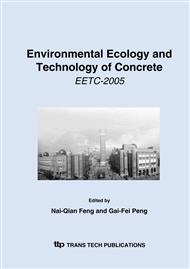[1]
Ian Sims: Alkali-reactivity-solving the problem worldwide, Concrete, November/December 2000, pp.64-66.
Google Scholar
[2]
Tang Mingshu, Xu Zhongzi, Deng Min, Han Sufen and Lan Xianghui: Alkali-aggregate reaction in China, In: S. Nishibayashi and M. Kawamura, Proceedings of east Asia AAR seminar (Torri, Japan, 1997), pp.1-10.
Google Scholar
[3]
Zhao Jun, Lou Lihua and Ruan Hongyan: Investigation of the ASR damage to concrete bridges in Beijing, Concrete and Cement Products, 1993(6), pp.22-24 (In Chinese).
Google Scholar
[4]
Jin Jinhua, Xie Yongjiang and Pan tingyu: Surveying of AAR in railway PC girders and sleepers, Development of Construction Technology, 1996(6), pp.36-40 (In Chinese).
Google Scholar
[5]
Liu Zhongxun: Detection of deterioration of concrete bridges, Technical Report (private communication), Beiing, 2002, pp.1-10 (In Chinese).
Google Scholar
[6]
Chen Zhiyuan, Sun Jiaying and Sun Jian: High strength concrete and AAR, In: S. Nishibayashi and M. Kawamura, Proceedings of east Asia AAR seminar (Torri, Japan) 1997, pp.243-255.
Google Scholar
[7]
Hao, Ting-Yu: Diagnosis and Analysis of durability problem of Baikong Bridge in Shijiazhuang, Technical report of NERC, Beijing, 2001, pp.6-15 (In Chinese).
Google Scholar
[8]
M. O. Broga Reis, H. S. Silva and A. S. Silva: AAR in Portuguese structures: Some case histories, In: A. Shayan editor, Proceedings of the 10 th International Conference of Alkali- Aggregate Reaction (Melbourne, 1996), pp.93-100.
Google Scholar
[9]
W. F. Cole, C. J. Lancucki and M. J. Sandy: Products formed in an aged concrete, Cement and concrete Research, 1981, 11, pp.443-454.
DOI: 10.1016/0008-8846(81)90116-2
Google Scholar
[10]
Gilles Escadeillas, Andre Carles Gibergues, Eric Massias: A case study of alkali-silica reaction in high-density concrete, In: M. A. Berube, B. Fournier, B. Durand editors, Proceedings of the 11 th ICAAR(Quebec City, Canada, 2000), p.834.
Google Scholar
[11]
R. N. Swamy: The alkali-silica reaction in Concrete (New York, Blackie and Son Ltd., 1992), pp.273-274.
Google Scholar
[12]
Jonathan G. M. Wood and R. Ashley Johnson etc: AAR in the United Kingdom-Assessment of structural damage, remedial measures and the development of Specifications, In: Benoit Fournier, eds, CANMET/ACI International Workshop on Alkali-Aggregate Reaction in Concrete, Dartmouth, Nova Scotia, 1995, pp.349-354.
Google Scholar
[13]
Jiang Yuantong, Han Sufang: Deterioration of concrete structures and rehabilitation (China Ocean Press, Beijing, 1996).
Google Scholar
[14]
JCI AAR-3-1987, Concrete bar method for assessing AAR (In Japanese).
Google Scholar
[15]
K. Kubo, Y. Okuda, K. Ishii and K. Torii: A strengthening method with PC-wires of reinforced concrete piers deteriorated by ASR, In: S. Nishibayashi and M. Kawamura, Proceedings of East Asia AAR seminar (Torri, Japan, 1997), pp.289-290.
Google Scholar


